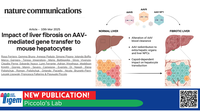Impact of liver fibrosis on AAV-mediated gene transfer to mouse hepatocytes
Authors: Rosa Ferriero, Gemma Bruno, Agnese Padula, Simone Pisano, Iolanda Boffa, Marco Gargaro, Teresa Imperatore, Maria Battipaglia, Silvia Vivenzio, Claudia Perna, Edoardo Nusco, Luigi Ferrante, Adrian Westhaus, Maddison Knight, Giorgia Manni, Severo Campione, Evaristo Di Napoli, Elena Polishchuk, Roman Polishchuk, Orlando Paciello, Nicola Brunetti-Pierri, Leszek Lisowski, Francesca Fallarino & Pasquale Piccolo
Year: 2025
Sources: nature communications
Abstract:
Liver fibrosis, characterized by scar tissue accumulation due to liver injury, poses significant barriers to liver-targeted gene therapy. Current clinical trials exclude patients with fibrosis, as intact liver architecture is considered essential for efficient and safe adeno-associated viral vector (AAV)-mediated gene delivery. Here, we show that liver fibrosis reduces the efficiency of hepatocyte transduction by AAV8 vectors across three mouse models with diverse fibrotic patterns. This inefficiency stems primarily from decreased vector uptake by the liver rather than loss of vector genomes due to hepatocyte turnover. Additionally, fibrosis alters blood vector clearance and redistributes AAV particles to extra-hepatic organs, such as spleen, lung, and kidney. At the cellular level, fibrosis decreases AAV genome content in hepatocytes while increasing it in non-parenchymal liver cells and splenic immune cells. Importantly, the capsid variant AAV-KP1 retains transduction efficiency in fibrotic livers, highlighting its potential for expanding gene therapy applications to fibrotic diseases.
Category: journals

